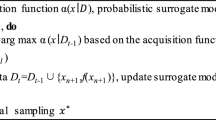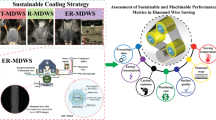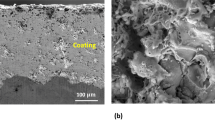Abstract
The primary bottlenecks faced by the laser powder bed fusion (LPBF) process is the identification of optimal process parameters to obtain high density (> 99.8%) and a good surface finish (< 10 µm) in the fabricated components. Prediction of optimal process maps with the help of machine learning (ML) models is still challenging due to extensive training data, which proves to be expensive in additive manufacturing. In view of this, the present study employs six different supervised ML algorithms on a comparatively small data set of 33 experiments to predict relative density and surface roughness. It has been observed that input data (predictor) curation can increase the accuracy of the ML models even with a small data set. In the ML prediction model, the mean absolute percentage error (MAPE) was reduced by 30% (relative density) and 21.94% (surface roughness) with volumetric energy density as an input parameter instead of laser power, scanning speed, hatch space, and layer thickness. The choice of non-dimensional energy input as a universal predictor allows for an increase in training size and the translation capability of trained ML models from one machine/material combination to another. The ML model based on increased training data size (198 for relative density and 173 for surface roughness) procured from the material processed/fabricated on different LPBF machines showcased reasonable R2 values of 79.11% and 80.3% for relative density and surface roughness, respectively.


















Similar content being viewed by others
References
Aoyagi, K., Wang, H., Sudo, H., & Chiba, A. (2019). Simple method to construct process maps for additive manufacturing using a support vector machine. Additive Manufacturing, 27(March), 353–362. https://doi.org/10.1016/j.addma.2019.03.013
Appleyard, D. (2015). Powering up on powder technology. Metal Powder Report, 70(6), 285–289. https://doi.org/10.1016/j.mprp.2015.08.075
Arlot, S., & Celisse, A. (2010). A survey of cross-validation procedures for model selection. Statistics Surveys, 4, 40–79. https://doi.org/10.1214/09-SS054
Awad Mariette, K. R. (2015). Support vector regression. In Efficient learning machines (pp. 67–80). https://doi.org/10.1007/978-1-4302-5990-9_.
Balbaa, M., Mekhiel, S., Elbestawi, M., & McIsaac, J. (2020). On selective laser melting of Inconel 718: Densification, surface roughness, and residual stresses. Materials and Design, 193, 108818. https://doi.org/10.1016/j.matdes.2020.108818
Barrett, C., Carradero, C., Harris, E., Rogers, K., MacDonald, E., & Conner, B. (2019). Statistical analysis of spatter velocity with high-speed stereovision in laser powder bed fusion. Progress in Additive Manufacturing, 4(4), 423–430. https://doi.org/10.1007/s40964-019-00094-6
Barrionuevo, G. O., Ramos-Grez, J. A., Walczak, M., & Betancourt, C. A. (2021). Comparative evaluation of supervised machine learning algorithms in the prediction of the relative density of 316L stainless steel fabricated by selective laser melting. International Journal of Advanced Manufacturing Technology, 113(1–2), 419–433. https://doi.org/10.1007/s00170-021-06596-4
Baturynska, I., & Martinsen, K. (2021). Prediction of geometry deviations in additive manufactured parts: Comparison of linear regression with machine learning algorithms. Journal of Intelligent Manufacturing, 32(1), 179–200. https://doi.org/10.1007/s10845-020-01567-0
Bayat, M., Thanki, A., Mohanty, S., Witvrouw, A., Yang, S., Thorborg, J., Tiedje, N. S., & Hattel, J. H. (2019). Keyhole-induced porosities in Laser-based Powder Bed Fusion (L-PBF) of Ti6Al4V: High-fidelity modelling and experimental validation. Additive Manufacturing, 30(July), 100835. https://doi.org/10.1016/j.addma.2019.100835
Bengio, Y., & Grandvalet, Y. (2004). No unbiased estimator of the variance of K-fold cross-validation. Journal of Machine Learning Research, 5(302, 4), 860–864. https://doi.org/10.1016/S0006-291X(03)00224-9
Chen, B., Yao, Y., Song, X., Tan, C., Cao, L., & Feng, J. (2018). Microstructure and mechanical properties of additive manufacturing AlSi10Mg alloy using direct metal deposition. Ferroelectrics, 523(1), 153–166. https://doi.org/10.1080/00150193.2018.1392147
Cheng, L., Tsung, F., & Wang, A. (2017). A statistical transfer learning perspective for modeling shape deviations in additive manufacturing. IEEE Robotics and Automation Letters, 2(4), 1988–1993. https://doi.org/10.1109/LRA.2017.2713238
Cheng, L., Wang, K., & Tsung, F. (2020). A hybrid transfer learning framework for in-plane freeform shape accuracy control in additive manufacturing. IISE Transactions, 53(3), 298–312. https://doi.org/10.1080/24725854.2020.1741741
Coatanéa, E., Paris, H., & Koskinen, K. (2016). Analysis conceptual modeling (DACM) framework for Additive. In Proceedings of the ASME 2016 international design engineering technical conferences and computers and information in engineering conference IDETC/CIE 2016, August 21–24, 2016, Charlotte, North Carolina (pp. 1–9).
Cui, X., Zhang, S., Zhang, C. H., Chen, J., Zhang, J. B., & Dong, S. Y. (2021). Additive manufacturing of 24CrNiMo low alloy steel by selective laser melting: Influence of volumetric energy density on densification, microstructure and hardness. Materials Science and Engineering A, 809(February), 140957. https://doi.org/10.1016/j.msea.2021.140957
Cunningham, R., Zhao, C., Parab, N., Kantzos, C., Pauza, J., Fezzaa, K., Sun, T., & Rollett, A. D. (2019). Keyhole threshold and morphology in laser melting revealed by ultrahigh-speed X-ray imaging. Science, 363(6429), 849–852. https://doi.org/10.1126/science.aav4687
DebRoy, T., Mukherjee, T., Milewski, J. O., Elmer, J. W., Ribic, B., Blecher, J. J., & Zhang, W. (2019). Scientific, technological and economic issues in metal printing and their solutions. Nature Materials, 18(10), 1026–1032. https://doi.org/10.1038/s41563-019-0408-2
DebRoy, T., Wei, H. L., Zuback, J. S., Mukherjee, T., Elmer, J. W., Milewski, J. O., Beese, A. M., Wilson-Heid, A., De, A., & Zhang, W. (2018). Additive manufacturing of metallic components—Process, structure and properties. Progress in Materials Science, 92, 112–224. https://doi.org/10.1016/j.pmatsci.2017.10.001
Douard, A., Grandvallet, C., Pourroy, F., & Vignat, F. (2019). An example of machine learning applied in additive manufacturing. In: IEEE international conference on industrial engineering and engineering management, 2019, December (pp. 1746–1750). https://doi.org/10.1109/IEEM.2018.8607275.
Drucker, H., Surges, C. J. C., Kaufman, L., Smola, A., & Vapnik, V. (1997). Support vector regression machines. In Advances in neural information processing systems (Vol. x, pp. 155–161).
Garg, A., Lam, J. S. L., & Savalani, M. M. (2015). A new computational intelligence approach in formulation of functional relationship of open porosity of the additive manufacturing process. International Journal of Advanced Manufacturing Technology, 80(1–4), 555–565. https://doi.org/10.1007/s00170-015-6989-2
Gu, H., Wei, C., Li, L., Han, Q., Setchi, R., Ryan, M., & Li, Q. (2020). Multi-physics modelling of molten pool development and track formation in multi-track, multi-layer and multi-material selective laser melting. International Journal of Heat and Mass Transfer, 151, 119458. https://doi.org/10.1016/j.ijheatmasstransfer.2020.119458
Gu, D., Dai, D., Chen, W., & Chen, H. (2016). Selective laser melting additive manufacturing of hard-to-process tungsten-based alloy parts with novel crystalline growth morphology and enhanced performance. Journal of Manufacturing Science and Engineering, Transactions of the ASME, 138(8), 1–11. https://doi.org/10.1115/1.4032192
Ghouse, S., Babu, S., van Arkel, R. J., Nai, K., Hooper, P. A., & Jeffers, J. R. T. (2017). The influence of laser parameters and scanning strategies on the mechanical properties of a stochastic porous material. Materials and Design, 131, 498– 508. https://doi.org/10.1016/J.MATDES.2017.06.041
Johnson, N. S., Vulimiri, P. S., To, A. C., Zhang, X., Brice, C. A., Kappes, B. B., & Stebner, A. P. (2020). Invited review: Machine learning for materials developments in metals additive manufacturing. Additive Manufacturing. https://doi.org/10.1016/j.addma.2020.101641
Kamath, C. (2016). Data mining and statistical inference in selective laser melting. International Journal of Advanced Manufacturing Technology, 86(5–8), 1659–1677. https://doi.org/10.1007/s00170-015-8289-2
Kappes, B., Moorthy, S., Drake, D., Geerlings, H., & Stebner, A. (2018). Machine learning to optimize additive manufacturing parameters for laser powder bed fusion of Inconel 718. Minerals, Metals and Materials Series (Vol. 2018 June). Springer. https://doi.org/10.1007/978-3-319-89480-5_39.
Khairallah, S. A., Anderson, A. T., Rubenchik, A. M., & King, W. E. (2017). Laser powder-bed fusion additive manufacturing: Physics of complex melt flow and formation mechanisms of pores, spatter, and denudation zones. Additive Manufacturing Handbook: Product Development for the Defense Industry, 54(9), 613–628. https://doi.org/10.1201/9781315119106
King, W. E., Barth, H. D., Castillo, V. M., Gallegos, G. F., Gibbs, J. W., Hahn, D. E., Kamath, C., & Rubenchik, A. M. (2014). Observation of keyhole-mode laser melting in laser powder-bed fusion additive manufacturing. Journal of Materials Processing Technology, 214(12), 2915–2925. https://doi.org/10.1016/j.jmatprotec.2014.06.005
la Fé-Perdomo, I., Ramos-Grez, J., Mujica, R., & Rivas, M. (2021). Surface roughness Ra prediction in Selective Laser Melting of 316L stainless steel by means of artificial intelligence inference. Journal of King Saud University Engineering Sciences. https://doi.org/10.1016/j.jksues.2021.03.002
Larimian, T., Kannan, M., Grzesiak, D., AlMangour, B., & Borkar, T. (2020). Effect of energy density and scanning strategy on densification, microstructure and mechanical properties of 316L stainless steel processed via selective laser melting. Materials Science and Engineering A, 770, 138455. https://doi.org/10.1016/j.msea.2019.138455
Le, K. Q., Tang, C., & Wong, C. H. (2019). On the study of keyhole-mode melting in selective laser melting process. International Journal of Thermal Sciences. https://doi.org/10.1016/j.ijthermalsci.2019.105992
Lee, S., Peng, J., Shin, D., & Choi, Y. S. (2019). Data analytics approach for melt-pool geometries in metal additive manufacturing. Science and Technology of Advanced Materials, 20(1), 972–978. https://doi.org/10.1080/14686996.2019.1671140
Liu, R., Liu, S., & Zhang, X. (2021). A physics-informed machine learning model for porosity analysis in laser powder bed fusion additive manufacturing. International Journal of Advanced Manufacturing Technology. https://doi.org/10.1007/s00170-021-06640-3
Lin, K., Gu, D., Xi, L., Yuan, L., Niu, S., Lv, P., & Ge, Q. (2019). Selective laser melting processing of 316L stainless steel: Effect of microstructural differences along building direction on corrosion behavior. International Journal of Advanced Manufacturing Technology, 104(5–8), 2669–2679. https://doi.org/10.1007/s00170-019-04136-9
Lv, F., Shen, L., Liang, H., Xie, D., Wang, C., & Tian, Z. (2019). Mechanical properties of AlSi10Mg alloy fabricated by laser melting deposition and improvements via heat treatment. Optik, 179, 8–18. https://doi.org/10.1016/J.IJLEO.2018.10.112
Meng, L., & Zhang, J. (2020). Process design of laser powder bed fusion of stainless steel using a Gaussian process-based machine learning model. JOM Journal of the Minerals Metals and Materials Society, 72(1), 420–428. https://doi.org/10.1007/s11837-019-03792-2
Mumtaz, K., & Hopkinson, N. (2009). Top surface and side roughness of Inconel 625 parts processed using selective laser melting. Rapid Prototyping Journal, 15(2), 96–103. https://doi.org/10.1108/13552540910943397
Murr, L. E., Martinez, E., Gaytan, S. M., Ramirez, D. A., Machado, B. I., Shindo, P. W., Martinez, J. L., Medina, F., Wooten, J., Ciscel, D., Ackelid, U., & Wicker, R. B. (2011). Microstructural architecture, microstructures, and mechanical properties for a nickel-base superalloy fabricated by electron beam melting. Metallurgical and Materials Transactions A: Physical Metallurgy and Materials Science, 42(11), 3491–3508. https://doi.org/10.1007/S11661-011-0748-2
Mutua, J., Nakata, S., Onda, T., & Chen, Z. C. (2018). Optimization of selective laser melting parameters and influence of post heat treatment on microstructure and mechanical properties of Maraging steel. Materials and Design, 139, 486–497. https://doi.org/10.1016/j.matdes.2017.11.042
Nagarajan, H. P. N., Mokhtarian, H., Jafarian, H., Dimassi, S., Bakrani-Balani, S., Hamedi, A., Coatanéa, E., Gary Wang, G., & Haapala, K. R. (2019). Knowledge-based design of artificial neural network topology for additive manufacturing process modeling: A new approach and case study for fused deposition modeling. Journal of Mechanical Design, Transactions of the ASME, 141(2), 1–12. https://doi.org/10.1115/1.4042084
Nguyen, Q. H., Ly, H. B., Ho, L. S., Al-Ansari, N., Van Le, H., Tran, V. Q., Prakash, I., & Pham, B. T. (2021). Influence of data splitting on performance of machine learning models in prediction of shear strength of soil. Mathematical Problems in Engineering. https://doi.org/10.1155/2021/4832864
Pal, S., Lojen, G., Kokol, V., & Drstvensek, I. (2018). Evolution of metallurgical properties of Ti–6Al–4V alloy fabricated in different energy densities in the Selective Laser Melting technique. Journal of Manufacturing Processes, 35(November 2017), 538–546. https://doi.org/10.1016/j.jmapro.2018.09.012
Patel, S., & Vlasea, M. (2020). Melting modes in laser powder bed fusion. Materialia. https://doi.org/10.1016/j.mtla.2020.100591
Qi, T., Zhu, H., Zhang, H., Yin, J., Ke, L., & Zeng, X. (2017). Selective laser melting of Al7050 powder: Melting mode transition and comparison of the characteristics between the keyhole and conduction mode. Materials and Design, 135, 257–266. https://doi.org/10.1016/j.matdes.2017.09.014
Rankouhi, B., Agrawal, A. K., Pfefferkorn, F. E., & Thoma, D. J. (2021a). A dimensionless number for predicting universal processing parameter boundaries in metal powder bed additive manufacturing. Manufacturing Letters, 27, 13–17. https://doi.org/10.1016/j.mfglet.2020.12.002
Rankouhi, B., Jahani, S., Pfefferkorn, F. E., & Thoma, D. J. (2021b). Compositional grading of a 316L-Cu multi-material part using machine learning for the determination of selective laser melting process parameters. Additive Manufacturing, 38(January), 101836. https://doi.org/10.1016/j.addma.2021.101836
Scipioni Bertoli, U., Wolfer, A. J., Matthews, M. J., Delplanque, J. P. R., & Schoenung, J. M. (2017). On the limitations of Volumetric Energy Density as a design parameter for Selective Laser Melting. Materials and Design, 113, 331–340. https://doi.org/10.1016/j.matdes.2016.10.037
Sert, E., Hitzler, L., Hafenstein, S., Merkel, M., Werner, E., & Öchsner, A. (2020). Tensile and compressive behaviour of additively manufactured AlSi10Mg samples. Progress in Additive Manufacturing, 5(3), 305–313. https://doi.org/10.1007/S40964-020-00131-9
Sharma, S., Ramakrishna, S. A., & Ramkumar, J. (2020). Numerical simulation of melt hydrodynamics in laser micro processing of metals. Procedia CIRP, 95, 944–949. https://doi.org/10.1016/j.procir.2020.01.186
Shrestha, S., & Kevin Chou, Y. (2019). A numerical study on the keyhole formation during laser powder bed fusion process. Journal of Manufacturing Science and Engineering, 141(10), 1–9. https://doi.org/10.1115/1.4044100
Singh, A., Cooper, D. E., Blundell, N. J., Gibbons, G. J., & Pratihar, D. K. (2013). Modelling of direct metal laser sintering of EOS DM20 bronze using neural networks and genetic algorithms. In Proceedings of the 37th international MATADOR 2012 conference (pp. 395–398).
Sow, M. C., de Terris, T., Castelnau, O., Hamouche, Z., Coste, F., Fabbro, R., & Peyre, P. (2020). Influence of beam diameter on Laser Powder Bed Fusion (L-PBF) process. Additive Manufacturing, 36, 101532. https://doi.org/10.1016/j.addma.2020.101532
Tan, J. L., Tang, C., & Wong, C. H. (2018). A computational study on porosity evolution in parts produced by selective laser melting. Metallurgical and Materials Transactions A: Physical Metallurgy and Materials Science, 49(8), 3663–3673. https://doi.org/10.1007/s11661-018-4697-x
Tang, C., Le, K. Q., & Wong, C. H. (2020). Physics of humping formation in laser powder bed fusion. International Journal of Heat and Mass Transfer. https://doi.org/10.1016/j.ijheatmasstransfer.2019.119172
Tang, C., Tan, J. L., & Wong, C. H. (2018). A numerical investigation on the physical mechanisms of single track defects in selective laser melting. International Journal of Heat and Mass Transfer, 126, 957–968. https://doi.org/10.1016/j.ijheatmasstransfer.2018.06.073
Tapia, G., Elwany, A. H., & Sang, H. (2016). Prediction of porosity in metal-based additive manufacturing using spatial Gaussian process models. Additive Manufacturing, 12, 282–290. https://doi.org/10.1016/j.addma.2016.05.009
Tapia, G., Khairallah, S., Matthews, M., King, W. E., & Elwany, A. (2018). Gaussian process-based surrogate modeling framework for process planning in laser powder-bed fusion additive manufacturing of 316L stainless steel. International Journal of Advanced Manufacturing Technology, 94(9–12), 3591–3603. https://doi.org/10.1007/s00170-017-1045-z
Tong, Z., Ren, X., Jiao, J., Zhou, W., Ren, Y., Ye, Y., Larson, E. A., & Gu, J. (2019). Laser additive manufacturing of FeCrCoMnNi high-entropy alloy: Effect of heat treatment on microstructure, residual stress and mechanical property. Journal of Alloys and Compounds, 785, 1144–1159. https://doi.org/10.1016/j.jallcom.2019.01.213
Tran, H. C., & Lo, Y. L. (2019). Systematic approach for determining optimal processing parameters to produce parts with high density in selective laser melting process. International Journal of Advanced Manufacturing Technology. https://doi.org/10.1007/s00170-019-04517-0
Trapp, J., Rubenchik, A. M., Guss, G., & Matthews, M. J. (2017). In situ absorptivity measurements of metallic powders during laser powder-bed fusion additive manufacturing. Applied Materials Today, 9, 341–349. https://doi.org/10.1016/j.apmt.2017.08.006
Wang, D., Liu, Y., Yang, Y., & Xiao, D. (2016). Theoretical and experimental study on surface roughness of 316L stainless steel metal parts obtained through selective laser melting. Rapid Prototyping Journal, 22(4), 706–716. https://doi.org/10.1108/RPJ-06-2015-0078
Wang, L., Chen, X., Henkel, D., & Jin, R. (2021). Family learning: A process modeling method for cyber-additive manufacturing network. IISE Transactions, 54(1), 1–16. https://doi.org/10.1080/24725854.2020.1851824
Wang, Z., Yan, W., Liu, W. K., & Liu, M. (2019). Powder-scale multi-physics modeling of multi-layer multi-track selective laser melting with sharp interface capturing method. Computational Mechanics, 63(4), 649–661. https://doi.org/10.1007/s00466-018-1614-5
Wei, H. L., Mukherjee, T., Zhang, W., Zuback, J. S., Knapp, G. L., De, A., & DebRoy, T. (2021). Mechanistic models for additive manufacturing of metallic components. Progress in Materials Science. https://doi.org/10.1016/j.pmatsci.2020.100703
Wu, C., Zafar, M. Q., Wang, Y., Schöler, C., Niessen, M., Schulz, W., Wang, Y., Schöler, C., Heinigk, C., & Niessen, M. (2021). Multi-physics modeling of side roughness generation mechanisms in powder bed fusion. Additive Manufacturing, 102274. https://doi.org/10.1016/j.addma.2021.102274
Yakout, M., Elbestawi, M. A., & Veldhuis, S. C. (2019). Density and mechanical properties in selective laser melting of Invar 36 and stainless steel 316L. Journal of Materials Processing Technology, 266(July 2018), 397–420. https://doi.org/10.1016/j.jmatprotec.2018.11.006
Yan, X., Chang, C., Dong, D., Gao, S., Ma, W., Liu, M., Liao, H., & Yin, S. (2020). Microstructure and mechanical properties of pure copper manufactured by selective laser melting. Materials Science and Engineering A, 789(May), 139615. https://doi.org/10.1016/j.msea.2020.139615
Yin, J., Wang, D., Yang, L., Wei, H., Dong, P., Ke, L., Wang, G., Zhu, H., & Zeng, X. (2020). Correlation between forming quality and spatter dynamics in laser powder bed fusion. Additive Manufacturing, 31(November 2019), 100958. https://doi.org/10.1016/j.addma.2019.100958
Young, Z. A., Guo, Q., Parab, N. D., Zhao, C., Qu, M., Escano, L. I., Fezzaa, K., Everhart, W., Sun, T., & Chen, L. (2020). Types of spatter and their features and formation mechanisms in laser powder bed fusion additive manufacturing process. Additive Manufacturing, 36(March), 101438. https://doi.org/10.1016/j.addma.2020.101438
Zhang, M., Sun, C. N., Zhang, X., Goh, P. C., Wei, J., Hardacre, D., & Li, H. (2019). High cycle fatigue life prediction of laser additive manufactured stainless steel: A machine learning approach. International Journal of Fatigue, 128(May), 105194. https://doi.org/10.1016/j.ijfatigue.2019.105194
Zhang, W., Mehta, A., Desai, P. S., & Fred Higgs, C. (2020). Machine learning enabled powder spreading process map for metal additive manufacturing (AM). In Solid freeform fabrication 2017: Proceedings of the 28th annual international solid freeform fabrication symposium—An additive manufacturing conference, SFF 2017 (pp. 1235–1249).
Acknowledgements
Authors acknowledge the infrastructure and support of Center for Agile and Adaptive and Additive Manufacturing (CAAAM) funded through State of Texas Appropriation: 190405-105-805008-220.
Author information
Authors and Affiliations
Contributions
Conceptualization: SS; Methodology: SS, ZG; Formal analysis and investigation: ZG, SS; ML Modeling: ZG; Writing—original draft preparation: SS, ZG; Writing—review and editing: SF, ND; Funding acquisition: ND, SF; Resources: ND, SF; Supervision: SF, ND; Experimental data characterization: DAR, MVP, SJ.
Corresponding author
Ethics declarations
Conflict of interest
No potential conflict of interest was reported by the author(s).
Additional information
Publisher's Note
Springer Nature remains neutral with regard to jurisdictional claims in published maps and institutional affiliations.
Rights and permissions
Springer Nature or its licensor holds exclusive rights to this article under a publishing agreement with the author(s) or other rightsholder(s); author self-archiving of the accepted manuscript version of this article is solely governed by the terms of such publishing agreement and applicable law.
About this article
Cite this article
Gu, Z., Sharma, S., Riley, D.A. et al. A universal predictor-based machine learning model for optimal process maps in laser powder bed fusion process. J Intell Manuf 34, 3341–3363 (2023). https://doi.org/10.1007/s10845-022-02004-0
Received:
Accepted:
Published:
Issue Date:
DOI: https://doi.org/10.1007/s10845-022-02004-0




